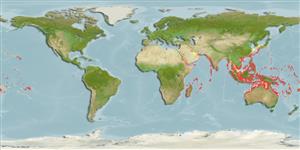Common names from other countries
>
Clupeiformes (Herrings) >
Spratelloididae (Small round herrings)
Etymology: Spratelloides: Old German, sprotte (1611) = a small fish, Clupea sp. + Greek, suffix, oides = similar to (Ref. 45335).
More on author: Bennett.
Issue
The species in the genera Spratelloides Bleeker, 1851 and Jenkinsia Jordan & Evermann, 1896 should most probably be assigned to a separated family from Clupeidae and Dussumieriidae (Lavoué, pers. comm., July 2013). See a preliminary analysis in Lavoué et al. (2013: Ref. 93878).
Environment: milieu / climate zone / depth range / distribution range
Écologie
marin récifal; profondeur 0 - 50 m (Ref. 188). Tropical; 40°N - 29°S, 29°E - 143°W (Ref. 188)
Indo-Pacific: Red Sea and East Africa to the Society Islands (but not the Tuamoto and Marquesas islands), north to southern Japan, south to northern Australia. Single specimen from eastern Mediterranean (Tel-Aviv, Israel).
Length at first maturity / Taille / Poids / Âge
Maturity: Lm ?, range 4 - ? cm
Max length : 7.0 cm SL mâle / non sexé; (Ref. 188)
Épines dorsales (Total) : 0; Rayons mous dorsaux (Total) : 11 - 13; Épines anales: 0; Rayons mous anaux: 10 - 11. No bright silver along band flanks, maxilla toothless; pre-maxillae triangular, 2 supra-maxillae, second supra-maxilla paddle-shaped and symmetrical; vertical striate on scales meeting at center, posterior margin of scales smooth, pre-dorsal scales 8 to 13; W-shaped pelvic scute, few branchiostegal rays (6 or 7).
Pelagic (Ref. 68964). Usually an inshore schooling species, inhabiting relatively clear coastal waters, lagoons, and along reef margins. Feeds near surface on plankton. Found in large schools (Ref. 9710). Pelagic (Ref. 58302). Marketed fresh or dried-salted (Ref. 5213) and used as tuna baitfish.
Whitehead, P.J.P., 1985. FAO Species Catalogue. Vol. 7. Clupeoid fishes of the world (suborder Clupeoidei). An annotated and illustrated catalogue of the herrings, sardines, pilchards, sprats, shads, anchovies and wolf-herrings. FAO Fish. Synop. 125(7/1):1-303. Rome: FAO. (Ref. 188)
Statut dans la liste rouge de l'IUCN (Ref. 130435)
CITES (Ref. 128078)
Not Evaluated
Menace pour l'homme
Harmless
Utilisations par l'homme
Pêcheries: intérêt commercial mineur; appât: usually
Outils
Articles particuliers
Télécharger en XML
Sources Internet
Estimates based on models
Preferred temperature (Ref.
115969): 24.7 - 29.1, mean 28.1 (based on 1228 cells).
Phylogenetic diversity index (Ref.
82804): PD
50 = 0.5625 [Uniqueness, from 0.5 = low to 2.0 = high].
Bayesian length-weight: a=0.00479 (0.00289 - 0.00793), b=3.17 (3.03 - 3.31), in cm Total Length, based on LWR estimates for this species & (Sub)family-body (Ref.
93245).
Niveau trophique (Ref.
69278): 3.1 ±0.0 se; based on diet studies.
Résilience (Ref.
120179): Haut, temps minimum de doublement de population inférieur à 15 mois (K=2.7-12.2; Fec=524; tm=0.14).
Fishing Vulnerability (Ref.
59153): Low vulnerability (10 of 100).
